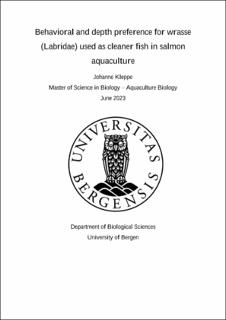| dc.description.abstract | Wild and farmed wrasse are used as cleaner fish in Norwegian salmon aquaculture as a biological remedy against the ectoparasite salmon lice. For wrasse to be a well-functioning cleaner fish, it is essential that the species can coexist with salmon in the cage environment. There have been reports of high mortality of wrasse in cages with salmon, and there is limited information about wrasse depth and behavior preference in a sea cage environment. Therefore, a trial of behavior and depth preference of wild-caught corkwing (Symphodus melops), goldsinny (Ctenolabrus rupestris), and wild-caught and farmed ballan wrasse (Labrus berggylta) was done in cages with and without Atlantic salmon (Salmo salar) present. The trial consisted of nine sea cages (12 x 12 m square) divided into three replicates. Three sea cages with salmon and wild-caught wrasse, three with only wild-caught wrasse, and three with salmon and farmed ballan wrasse during summer-autumn 2022. Behavioral and depth observations were done with underwater cameras three times a week for ten weeks during daylight. The cages were supplied with artificial kelp and feeding stations for wrasse with feeding blocks, pellets, and shrimp at three depths (3, 6, and 9 m). There was a clear difference in behavior for all wrasse species. Wrasse exhibited a greater variety of behaviors, and more observations was recorded in cages without salmon than in cages with salmon. In cages without salmon, goldsinny used the entire depth range, while in cages with salmon, goldsinny was most dominant at deeper depths. Corkwing was observed at the same depths in cages with and without salmon. Ballan was observed in the upper water layer, in cages with and without salmon, but slightly deeper in the cages with salmon, however this was based on very limited data. Farmed ballan wrasse was dominant at the bottom of the cages and was mainly observed resting, most likely due to poor fin welfare. Wrasse in cages with salmon had a twice as high mortality rate than wrasse in cages without salmon. The findings of the present study show that goldsinny and salmon have a mismatch in depth preference, so the possibility of performing cleaning behavior could be minimized. Corkwing and ballan wrasse share the same depth as salmon and are therefore more likely to perform cleaning behavior. The farmed ballan wrasse struggled to perform well in the sea cages due to poor fin welfare, therefore the chance of performing cleaning behavior was minimized. | |
